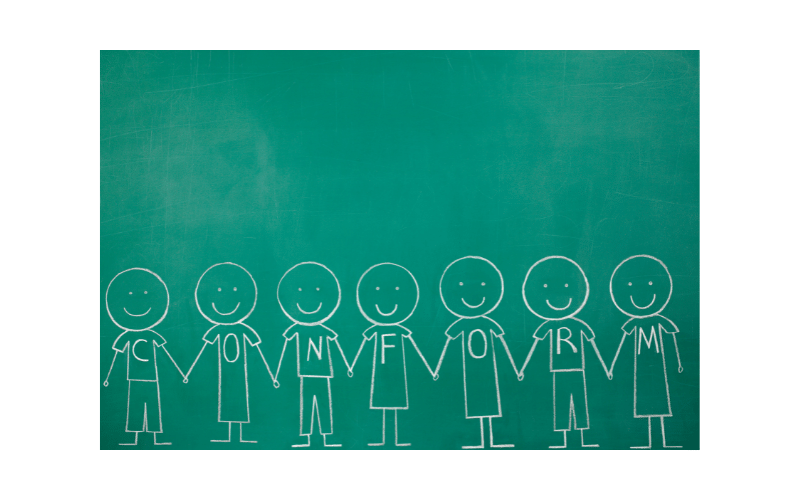What Is Conformity? Definition and Examples
Conformity involves changing your behavior to align with other people’s behaviors, beliefs, and attitudes. People often conform to blend in with others in their social group. It is a type of social influence that compels people to behave in ways seen as “normal” for that specific group. Researchers define conformity as “aligning one’s attitude, opinion…

Conformity involves changing your behavior to align with other people’s behaviors, beliefs, and attitudes. People often conform to blend in with others in their social group. It is a type of social influence that compels people to behave in ways seen as “normal” for that specific group.
Researchers define conformity as “aligning one’s attitude, opinion or behavior to those of others” (Stallen and Sanfey, 2015).
The presence of others can be a powerful force that can convince people that they need to change their beliefs and behaviors. Pressure from groups often leads people to conform with those around them, sometimes even if it conflicts with their personal goals or beliefs.
In this article, learn more about the different types of conformity, why people conform to the group, and how it can affect how people think and behave.

Types of Conformity
There are also several different types of social conformity that people may engage in.
Compliance
Compliance refers to changing behavior to gain a reward or avoid punishment. In the famous conformity experiment known as Asch’s conformity experiments, participants were offered a cash reward if they could correctly identify which comparison lines matched the standard line on a test. Many participants conformed and gave an incorrect answer rather than go against the rest of the group.
Complying involves changing your behavior, even though you might still disagree with the rest of the group.
Identification
This type of compliance involves changing behavior because people want to align their identity with the rest of a certain group. The conformity that typically takes place with this motivation is much more subtle than compliance.
Internalization
This type of conformity leads people to change their beliefs and attitudes because they desire to be like others. Internalization may lead to conformity out of the best interests of the individual. It may also lead to conformity out of the best interests of the groups they identify with.
Ingratiation
This type of conformity involves changing behavior in order to be accepted or favored by other people. People may ingratiate themselves to other members of the group in order to be liked, to gain power, or to obtain some other form of social reward.
Examples of Conformity
To better understand the meaning of conformity, it can be helpful to look at a few examples of how this phenomenon can affect behaviors. Some common examples of conformity include:
- Buying certain types of clothing because other people in your social group are wearing them
- Saying that you agree with other people in your social group just because you don’t want to stand out
- Standing up when you notice that other people are also standing up
- Giving into peer pressure
- Joining a club because other people you know are signing up
- Voting for the political candidates that your friends or family support
- Following a health or fitness trend because you see it everywhere on social media
- Buying specific products because you keep seeing people on social media promoting them
The conformity bias refers to the tendency to change behaviors or beliefs in order to fit in with a social group. This bias causes people to do what the group is doing rather than trusting their own judgment, knowledge, and experience.
What Causes Conformity?
While people often like to believe that they are independent and unique, the reality is that most of us conform in a wide variety of ways each and every day. People are naturally social creatures, so being able to fit in with our social groups plays an important part in social cohesion and group acceptance.
“People adjust their preferences, attitudes, and behaviors to conform to the norms of a group as a means of benefiting their social and physical welfare within the group, because social hierarchy profoundly affects the welfare of both animals and humans,” researchers suggest (Kim, Kim, and Kim, 2021).
People conform for various reasons, some of which can be positive and some negative. According to researchers, there are two primary reasons why people engage in conformity:

Informational Conformity
On the positive side, conformity can be a way to learn what to do in different situations and settings. If you are looking for people who are more informed and experienced, it can help guide your own actions. People tend to engage in information conformity when they lack knowledge or experience. They may also change their behavior to avoid looking foolish or incorrect.
Normative Conformity
Social norms and expectations can also influence conformity. The desire to fit in with groups and avoid being singled out for going against the status quo can also be a powerful motivation for conformity.
People may engage in normative conformity to avoid punishment, ridicule, or exclusion for standing out from the crowd. They may also conform in ways designed to get others from the group to like or approve of them.
People conform to the group for many reasons. Two of the most common reasons are to acquire information and avoid rejection.
Factors That Influence Conformity
We understand some of the reasons why people conform, but there are also other internal and situational variables that can impact whether or not people conform in different settings. These factors can affect how likely people are to conform to the rest of the group:
- Personal characteristics: Individual factors such as a person’s overall personality and goals can affect the degree to which they conform.
- Situational factors: When people encounter situations with unclear or ambiguous expectations, they may be more likely to look to others for information about what they should do and how they should behave.
- Group size: Asch’s classic conformity experiment found group size impacts conformity up to a certain point. People are most likely to conform when three to five other people are present.
- Status: People may be more likely to conform in situations where they feel that others have a higher status level than they do.
- Belongingness: Conformity tends to be higher when people have a strong sense of identification and cohesion with the rest of the group.
- Cultural influences: People from different cultural backgrounds may respond differently to social influences. In collectivist cultures, people are often more likely to conform to social expectations. People from individualist cultures may be less likely to do so.
- Difficulty level: If people are unknowledgeable, uncertain, or inexperienced, they are more likely to conform to what others in the group are doing.
Certain factors can impact whether or not people conform to the group. The size of the group, the difficulty of the task, the ambiguity of the situation, and the status of the individual are just a few influences that play a role.
The Effects of Conformity
Conformity can have a powerful influence on how people behave in different settings. It can potentially lead people to change their opinions and behaviors in various ways, both for good and for bad.
Socialization
Conformity can play an important role in the learning and socialization process during child development.
Kids often learn by watching and imitating the actions of others, a process that is known as observational learning. This can convey important information about what to do and how to behave in various situations.
Social Persuasion
Social pressure continues to influence life. People often alter their behavior, appearance, attitudes, or opinions to fit in with the rest of their social group. This can contribute to social harmony and group cohesiveness. It can help people to feel that they belong to a group, which an be a positive influence on a person’s mental health.
However, such pressure can also lead people to engage in risky or even harmful behaviors. It can also play a role in social phenomena such as the bystander effect, in which the presence of other people discourages people from helping others. In such situations, people observe others not intervening when help is needed, and the pressure to conform leads people to also fail to lend assistance.
In many cases, members of the group may utilize a range of tactics, including modeling, persuading, and even bullying to try to get other members of the group to conform to a certain set of expectations.
Conformity Research and Experiments
Several well-known psychology experiments have explored conformity. Such experiments have contributed to our understanding of why people conform and how it can affect behavior in both positive and negative ways.
Jenness’s Conformity Experiment
In one of the first experiments on conformity, psychologist Arthur Jenness asked participants to guess how many beans were in a glass bottle. People were asked individually and then later placed in a room to discuss. After the discussion, Jenness found that most participants changed their answers to conform to what the rest of the group had estimated.
Asch’s Conformity Experiments
During the 1950s, social psychologist Solomon Asch conducted experiments where participants were asked to perform a perceptual task. In this simple task, they had to look at a line and choose the line from a set of three different lines that matched the original one in terms of length.
However, other people in the group were in on the experiment and would intentionally select the wrong line. The results revealed that the majority of people (around 75% of the participants) would go along with the wrong answer at least one time.
Sherif’s Autokinetic Experiments
In these experiments, psychologist Muzafer Sherif had participants guess how far a light dot moved in a dark room. The movement of the light was actually due only to an autokinetic effect caused by the movements of the eyes.
Sherif found that when people were asked how far the light moved in part of a group, their answers all tended to be rather similar. However, when asked individually without the influence of the group, their answers were far more variable. His results indicated that because people were unsure, they looked to the rest of the group to inform their responses.
Several notable experiments have demonstrated how conformity affects behaviors. Famous experiments include Jenness’s conformity experiment, Asch’s conformity experiments, and Sherif’s autokinetic experiments.
How Does Conformity Differ From Obedience?
While conformity and obedience share some similarities, they are different concepts. Conformity involves changing your behavior, thoughts, or appearance to fit in with the rest of your social group. Obedience involves following the orders of another person, often a person with authority or status.
Simply put, conformity happens because people want to be socially accepted. Obedience happens as a result of power differentials in social roles.
How to Avoid Conformity
Conformity can have a positive and negative influence. On the plus side, it can encourage positive social behaviors and provide information that allows individuals to function effectively in their environments. On the negative side, it can stifle creativity and lead people to give in to destructive peer pressure.
Not everyone gives in to pressure from the social group. If you want to resist conforming in different social situations, experts suggest that you should:
Enlist Social Support
You’re less likely to conform to social pressure if you have a few people who are willing to resist alongside you. Talk to your friends and loved ones in such situations and ask them to stick with you when it comes to avoiding conforming to the rest of the group.
Form Clear, Committed Values and Beliefs
You are more likely to conform when you aren’t really sure about how to think, behave, or feel in a specific situation. Spend time thinking about your own beliefs, what’s important to you, and how you can commit to those values.
Develop an Internal Locus of Control
Locus of control refers to whether you believe you have control over your own destiny, or if you feel that outside forces are primarily responsible for what happens in your life. Having an internal locus of control means that you feel that you have the power to control what happens and that your own efforts can create change in your life. By strengthening this sense of control, you’ll be better able to resist social pressure to conform.
Practice
Resisting conforming requires practice. This doesn’t mean that you should be intentionally argumentative. Instead, work on standing your ground in situations where you might have otherwise conformed to the rest of the group.
Common Questions About Conformity
Why do people care about fitting in?
Belonging is a basic human need. Human beings are inherently social creatures, so being accepted by others is a way to gain a sense of community and closeness. In broader terms, social cohesion plays an important role in the success of a group. Conformity can allow groups to meet their goals, increase social harmony, and minimize interpersonal conflict.
Is conformity good or bad?
Conformity is often viewed negatively, particularly when it involves engaging in behaviors that are risky or destructive. However, conformity can also be a positive influence, particularly when it encourages people to engage in prosocial behaviors that support individual and community well-being.
However, it is important to recognize that conformity has a dark side. When people engage in conformity out of fear or as a way to avoid punishment, it can potentially play a role in terrible actions and large-scale atrocities.
Why do people conform to what others are doing?
One factor that can play a role in conformity is a phenomenon known as social proof. Social proof is a psychological phenomenon first described by psychologist Robert Cialdini in which people copy the actions of others to know how to act in a certain situation. This idea stems from the assumption that if other people are doing something, it must be the correct thing to do.
Sources:
Asch, SE. (1951). Effects of group pressure upon the modification and distortion of judgments. In H. Guetzkow (Ed.), Groups, Leadership and Men. Pittsburg, PA: Carnegie Press.
Deutsch, M., & Gerard, H. B. (1955). A study of normative and informational social influences upon individual judgment. The Journal of Abnormal and Social Psychology, 51(3), 629–636. https://doi.org/10.1037/h0046408
Jenness, A. (1932). The role of discussion in changing opinion regarding a matter of fact. The Journal of Abnormal and Social Psychology, 27(3), 279–296. https://doi.org/10.1037/h0074620
Kim, D., Kim, J., & Kim, H. (2021). Increased conformity to social hierarchy under public eyes. Frontiers in Psychology, 12, 636801. https://doi.org/10.3389/fpsyg.2021.636801
Sherif, M. (1935). A study of some social factors in perception. Archives of Psychology (Columbia University), 187, 60. https://psycnet.apa.org/record/1936-01332-001
Sowden, S., Koletsi, S., Lymberopoulos, E., Militaru, E., Catmur, C., & Bird, G. (2018). Quantifying compliance and acceptance through public and private social conformity. Consciousness and Cognition, 65, 359–367. https://doi.org/10.1016/j.concog.2018.08.009
Stallen, M., & Sanfey, A. G. (2015). The neuroscience of social conformity: implications for fundamental and applied research. Frontiers in Neuroscience, 9, 337. https://doi.org/10.3389/fnins.2015.00337
Toelch, U., & Dolan, R. J. (2015). Informational and normative influences in conformity from a neurocomputational perspective. Trends in Cognitive Sciences, 19(10), 579–589. https://doi.org/10.1016/j.tics.2015.07.007





